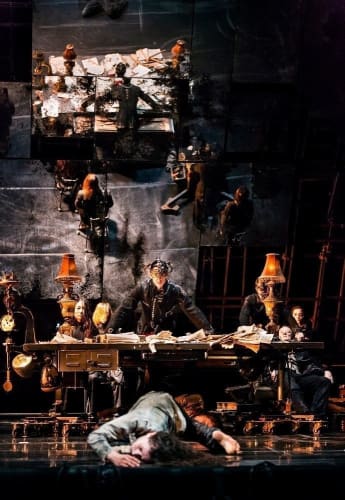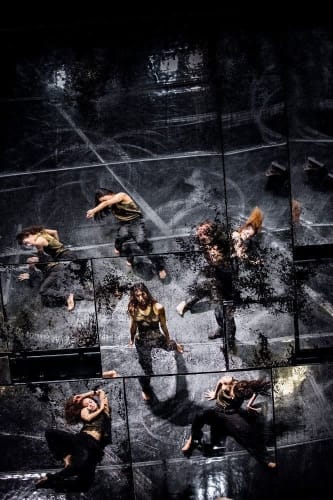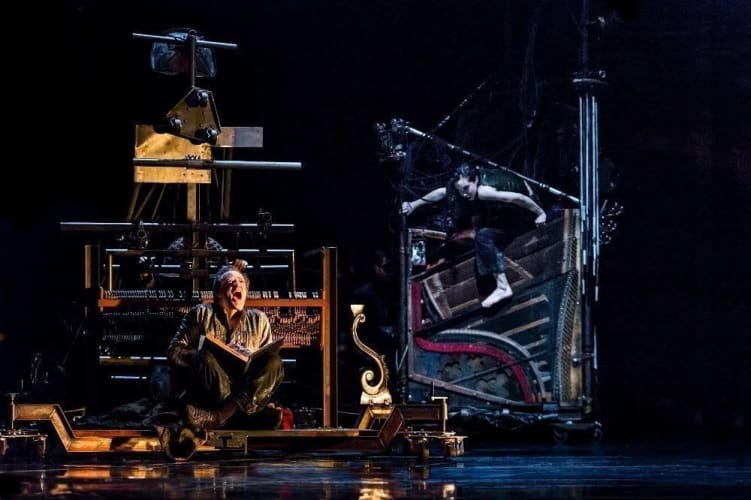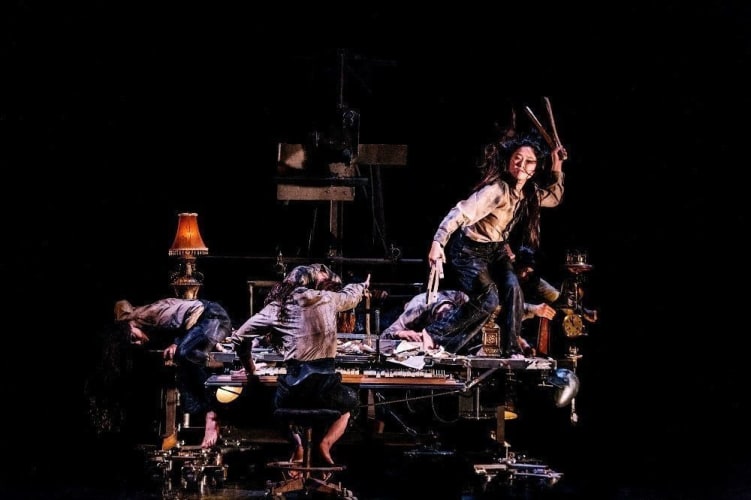A millefeuille James Thiérrée calls his latest epic fantasy, Tabac Rouge, a theatre of ideas, a crossroad of influences. I’d call it a potage of whatever is in the cupboard, a deep cupboard with some leftovers from Le Cirque Imaginaire and Le Cirque Invisible, his parents’ magnum opus, in which he figured as a boy, the legs of a suitcase.
Moving away from circus he has created a choreodrama, as he calls it, and he revels in the freedom of its ‘no specific genre’. Anything goes. Let the imagination loose, let’s play with the toolbox of theatre, which has always been his toy box.
Electric cables, lights, grids hanging down, climbing frames, bodies draped over them, all exposed. Martyn Jacques's (of Tiger Lillies fame) high falsetto sings Autumn Leaves over the speaker system, as we wait for the show to begin.
Dust-covered people emerge as if from the bowels of another world. Is that Mahler’s Fifth in noisy remix in that cacophony of sound? Humorous foley effects played to the hilt later mingle with scratchy recordings of Italian opera, classical music, and Hazmat’s Modine’s Bahamut (I think) to shake us out of Thiérrée’s world before we venture into the night.
Bahamut / Behemoth—that’s what Tabac Rouge is, a baggy behemoth of a show. Ninety minutes and more—it ran over, as Thiérrée is so at home on the stage he obviously doesn’t want to leave it—of Felliniesque self-indulgence.
Chaplinesque (how could it not be with his genes), Meyerholdian, a Factory of the Eccentric Actor. Do I hear Shostakovich? There is a narrative of sort, but we have to work it out. Who is this Personnage that he plays? Is he a Stalin dictator with his smoking pipe? Are we in a dystopian universe?
Is he Dr Coppelius with his magic workshop? Certainly he treats his chorus of six girls, his contortionist, acrobat, and amanuensis as creations at his beck and call. Is Tabac Rouge his Jabberwocky? “Twas bryllyg, and ye slythy toves Did gyre and gymble in ye wabe: All mimsy were ye borogoves; And ye mome raths outgrabe.” Sums it up.
Creatures of plastic and PVC slither forth till the floor swallows them up. A woman with a face-obscuring tasselled lampshade hat sits at a Singer treadle sewing machine—this must be homage to his mother, Victoria Chaplin Thiérrée, who is credited for the costumes. But his daftness is not his father’s, which I remember as much more benign, simple and charming.
A mess of ideas, references litter the work. It’s like trying to catch a mayfly. Festival fodder (reminds me a little of William Kentridge’s superior work, which I saw at the Avignon Festival in 2012), the inanimate made animate, Tabac Rouge will always find its audience.
Its visual impact is a Terry Gilliam overload of mad machinery cobbled together from post-apocalypse detritus into Heath Robinson contraptions on castors: a Versailles wall of silvered mirrors on a climbing frame that swings into a ceiling, a desk which doubles as a harmonium, except the keys come apart, an armchair for the shabby dictator / tyrant / director that Thiérrée plays, clothes and hair thick with white dust.
His performers are pliable, pliant, gifted. Contortion made to look as if it were the simplest thing in the world, crab girl Katell Le Brenn does not lose her head, though she tries. Piergiorgio Milano the acrobat and Manuel Rodriguez have too little to do, but the six girls moving as one are a force to be reckoned with when the plebeians rehearse / stage an uprising.
The hallucinatory Kafkaesque Tabac Rouge feels like a work in progress (apparently all his works are), an incoherent waking dream world. Take from it what you will, but its longueuers nearly had me drifting off into one of my own.
The pace is soporific, concentration wanders, patience is required. When electric shocks are administered to the helmsman, my wicked thought is don’t resuscitate him. Time to bring it to a close.
In a realm of his own, Thiérrée reminds me of Guiseppe Tornatore’s The Legend of 1900, a film of a pianist on an ocean liner, an abandoned baby, who never leaves the only home he knows and choses to go down with the ship in the end.



